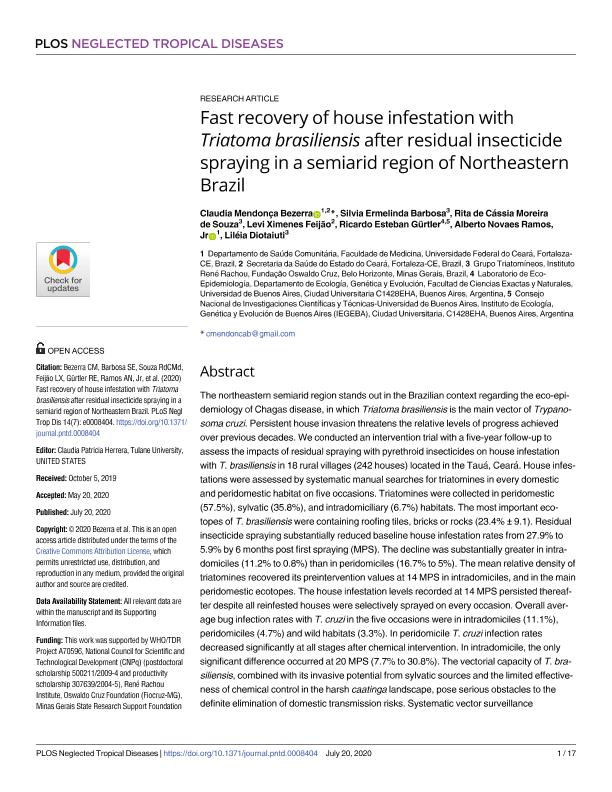Artículo
Fast recovery of house infestation with triatoma brasiliensis after residual insecticide spraying in a semiarid region of Northeastern Brazil
Bezerraid, Claudia Mendonça; Barbosa, Silvia Ermelinda; de Souza, Rita de Cássia Moreira; Feijão, Levi Ximenes; Gurtler, Ricardo Esteban ; Ramos, Alberto Novaes; Diotaiuti, Liléia
; Ramos, Alberto Novaes; Diotaiuti, Liléia
 ; Ramos, Alberto Novaes; Diotaiuti, Liléia
; Ramos, Alberto Novaes; Diotaiuti, Liléia
Fecha de publicación:
07/2020
Editorial:
Public Library of Science
Revista:
PLoS Neglected Tropical Diseases
ISSN:
1935-2735
Idioma:
Inglés
Tipo de recurso:
Artículo publicado
Clasificación temática:
Resumen
The northeastern semiarid region stands out in the Brazilian context regarding the eco-epi-demiology of Chagas disease, in which Triatoma brasiliensis is the main vector of Trypano-soma cruzi. Persistent house invasion threatens the relative levels of progress achieved over previous decades. We conducted an intervention trial with a five-year follow-up to assess the impacts of residual spraying with pyrethroid insecticides on house infestation with T. brasiliensis in 18 rural villages (242 houses) located in the Tauá, Ceará. House infes-tations were assessed by systematic manual searches for triatomines in every domestic and peridomestic habitat on five occasions. Triatomines were collected in peridomestic (57.5%), sylvatic (35.8%), and intradomiciliary (6.7%) habitats. The most important eco-topes of T. brasiliensis were containing roofing tiles, bricks or rocks (23.4% ± 9.1). Residual insecticide spraying substantially reduced baseline house infestation rates from 27.9% to 5.9% by 6 months post first spraying (MPS). The decline was substantially greater in intra-domiciles (11.2% to 0.8%) than in peridomiciles (16.7% to 5%). The mean relative density of triatomines recovered its preintervention values at 14 MPS in intradomiciles, and in the main peridomestic ecotopes. The house infestation levels recorded at 14 MPS persisted thereaf-ter despite all reinfested houses were selectively sprayed on every occasion. Overall aver-age bug infection rates with T. cruzi in the five occasions were in intradomiciles (11.1%), peridomiciles (4.7%) and wild habitats (3.3%). In peridomicile T. cruzi infection rates decreased significantly at all stages after chemical intervention. In intradomicile, the only significant difference occurred at 20 MPS (7.7% to 30.8%). The vectorial capacity of T. bra-siliensis, combined with its invasive potential from sylvatic sources and the limited effective-ness of chemical control in the harsh caatinga landscape, pose serious obstacles to the definite elimination of domestic transmission risks. Systematic vector surveillance supported by community participation and locally adapted environmental management measures are needed to reduce the risks of establishment of domestic transmission with T. cruzi in this region.
Palabras clave:
Chagas disease
,
vector control
,
Triatoma brasiliensis
,
reinfestation
Archivos asociados
Licencia
Identificadores
Colecciones
Articulos(IEGEBA)
Articulos de INSTITUTO DE ECOLOGIA, GENETICA Y EVOLUCION DE BS. AS
Articulos de INSTITUTO DE ECOLOGIA, GENETICA Y EVOLUCION DE BS. AS
Citación
Bezerraid, Claudia Mendonça; Barbosa, Silvia Ermelinda; de Souza, Rita de Cássia Moreira; Feijão, Levi Ximenes; Gurtler, Ricardo Esteban; et al.; Fast recovery of house infestation with triatoma brasiliensis after residual insecticide spraying in a semiarid region of Northeastern Brazil; Public Library of Science; PLoS Neglected Tropical Diseases; 14; 7; 7-2020; 1-17
Compartir
Altmétricas



